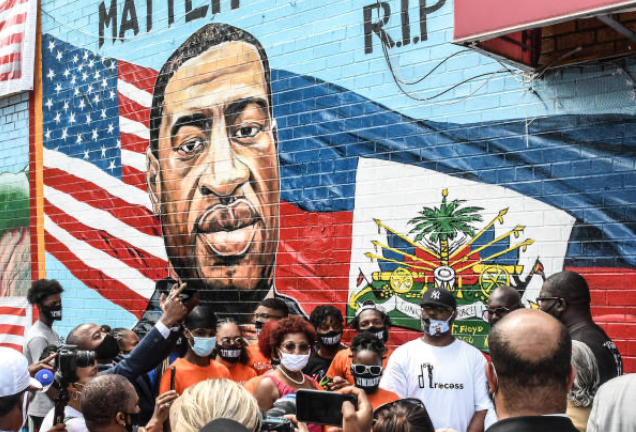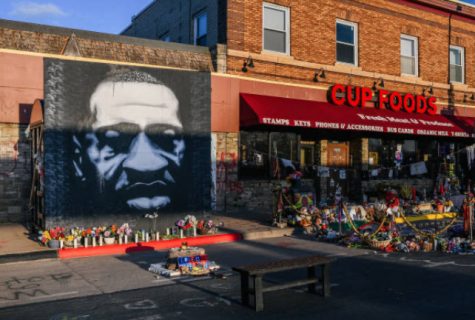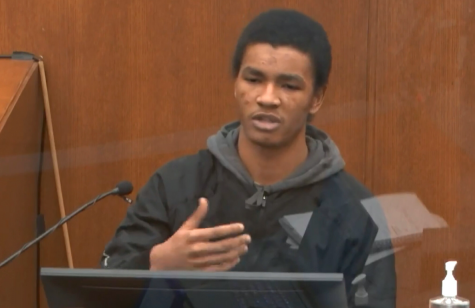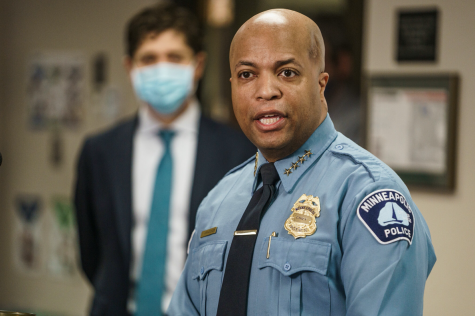
Amy Parr | Head Editor
April 6, 2021
Ten months after the murder that sparked protests across the globe, the police officer responsible for George Floyd’s death finally faces trial.
Derek Chauvin, former police officer, will face a jury composed of two white men, four white women, three black men, one black woman, and two multiracial women, whose identities are kept anonymous for their safety. His lawyer, Eric Nelson, will attempt to convince the jurors to look past the infamous video of Floyd, while the prosecution will ask the jury to look at the evidence for what it is; proof that George Floyd’s death was a direct result of racially motivated police brutality. On Monday, March 29, the trial began.
DAY ONE
The defense began their opening statements by fabricating Floyd’s death as a result of an agitating crowd, combined with Floyd’s drug use, size, and resistance to police officers. While it is true that the autopsy found traces of fentanyl and methamphetamine in Floyd’s system, it also ruled that his death was a result of hypoxia (oxygen deprivation). Despite this forensic evidence, Nelson argued that Floyd died from an overdose, which contradicts footage shown two days later of Floyd walking and talking normally two hours before his death.
“The defense will divert the jury’s attention onto Floyd’s drug use instead of looking at Chauvin’s actions,” junior Psi Padhya said. “It is clear as day that Chauvin committed murder, and the series of video proof cannot hide the police brutality that was involved.”
Hopefully the jurors will share these views and not be fooled by the defense’s feeble attempts at distracting them from the truth.

DAY TWO
On the next day of Chauvin’s trial, several eyewitnesses took the stand to recount their experiences on May 25, 2020. The teenager who filmed the encounter, Daniella Frazier, told the jury that Floyd’s cries for help still keep her up at night and that she regrets not physically intervening with police officers. Another witness, Donald Williams, recounted how he actually called the police on the then cop Derek Chauvin. “I believe I witnessed a murder,” he told the operator.
Isn’t it ironic that we need protecting from the people meant to protect us?
“Whenever something unlawful is happening, we look to the police to help the situation,” Padhya said. “However, it is so hard to put that trust into them when this is what is happening nowadays.”
Genevieve Hansen, an emergency medical technician who was also at the scene, told the jury how she urged the officers to check Floyd’s pulse. The disregard of her plea, whether motivated by ignorance or cruelty, potentially cost George Floyd his life.
“If the officers would have listened to Hansen as they should have, Floyd would still have the right to his life,” junior Cora LaFollette said. “But his God-given right to life was taken because these officers didn’t stop to check his pulse, even after a medical professional told them to.”
DAY THREE

Day three saw even more eyewitnesses reinforcing what video evidence proved to the world months and months ago. Christopher Martin, the cashier who noticed the counterfeit $20 bill Floyd used to pay for his purchase, told the jury about how he and Floyd were having a normal conversation, but Floyd did seem to be under the influence of some drug. This recording from the trial contains clips of Floyd laughing and talking, not knowing that he would be dead a mere two hours later.
More witnesses took to the stand, each one expressing some form of regret and nearly all of them succumbing to tears as they recalled their stories from May 25. Many explained how helpless they felt, watching this murder unfold and knowing that they would likely meet similar treatment for attempting to intervene, as they were frightened of further violence when Chauvin met their verbal protests with a touch of his mace.
“I do not think we should interfere with an officer while they are acting; it could lead to other, more serious issues,” Padhya said. “But there is a reason why jurors, a group of citizens, are chosen to take part in a case at the courthouse. Citizens can tell right from wrong, and in this case Derek Chauvin should have listened to bystanders.”
DAY FOUR
On day four, more witnesses took to the stand, most notably Courtney Ross (Floyd’s girlfriend of three years), former police sergeant David Ploeger, and paramedic Seth Bravinder. Ross gave details regarding Floyd’s drug use, informing the jury that they both had been sober on and off for the duration of their relationship, which the defense will likely use to their advantage later on to classify Floyd’s death as an overdose. Ploeger was asked whether or not appropriate force was used to restrain Floyd, and he explained that an officer should remove their knee from the suspect’s neck when resistance ceases, and according to video evidence, Floyd was already unresponsive, let alone unresistant, minutes before Chauvin removed his knee. Ravinder testified that upon arriving on the scene, Floyd displayed no signs of life.
“The defense is trying to disprove the video because it shows that Chauvin continued to kneel on Floyd for an unnecessary amount of time,” LaFollette said. “But the video and eyewitnesses say it all: that Chauvin overstepped his boundaries as a cop and killed George Floyd.”
DAY FIVE
On Friday, Lieutenant Richard Zimmerman, leader of the Minneapolis Police Department’s Homicide Unit and longest serving officer in the entire Minneapolis Police Department, took to the stand to offer his professional opinion regarding Chauvin’s actions. Back in June, Zimmerman, along with 13 other former police officers, wrote a letter to the public to explain that Chauvin’s actions are not representative of the police department as whole. Unsurprisingly, Zimmerman’s testimony further condemned Chauvin.
“Pulling him down to the ground facedown and putting your knee on a neck for that amount of time, it’s just uncalled for,” Zimmerman said. This testimony will likely be utilized by the prosecution to incriminate Chauvin further by proving that he did not act according to protocol.
DAY SIX
On the next day of the trial, two key witnesses were brought to the stand; the doctor who attempted to save George Floyd’s life, and the chief of Chauvin’s former police department.
Dr. Bradford T. Wankhede Langenfeld explained that the presence of methamphetamine and fentanyl in Floyd’s system is an unlikely cause of death, and that Floyd likely died after police officers at the scene failed to perform CPR, even after Floyd lost consciousness. The defense will have a harder time classifying Floyd’s death as an overdose after Langenfeld’s testimony.

The chief of the Minneapolis Police Department, Medaria Arradondo, supported Zimmerman’s claims that Chauvin did not behave according to police standards.
“Once Mr. Floyd had stopped resisting, and certainly once he was in distress and trying to verbalize that, that should have stopped,” Chief Arradondo said, referring to Chauvin kneeling on Floyd’s neck.
Additionally, former training director for the Minneapolis Police Department Katie Blackwell testified that Chauvin’s training taught him that he should have given Floyd medical help, and that a suspect pinned down by an officer’s knee should be removed from that position as soon as possible.
DAY SEVEN
The seventh day of the trial focused on whether or not Chauvin behaved according to police policy. Former Minneapolis police officer, Lieutenant Johnny Mercil, told jurors that Chauvin’s use of force did not align with officer training in restraining those who resist arrest.
In spite of this further condemnation of Chauvin’s actions, his lawyer, Eric Nelson, attempted to persuade jurors that the frenzied environment of Floyd’s arrest and subsequent murder challenged Chauvin and caused him to behave so aggressively. Nelson also suggested that Floyd’s unconsciousness was not a result of the knee restraint, asking Mercil if a person will only go unconscious when there is pressure on both sides of the neck.
“That is what we teach, yes,” Mercil said, which could be used to classify Floyd’s death as an overdose, since police officers are taught that someone will only fall unconscious with pressure on both sides of the neck, when Chauvin’s knee only pressured one side. However, it can be argued that since Floyd was pinned to the ground, there was indirect pressure on both sides of his neck, which would favor the prosecutions argument that Floyd’s death was not an overdose, but rather a result of racially motivated police brutality.

Leave a Reply